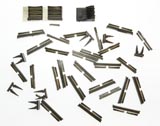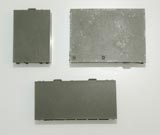

 Product number: Y35.158
Product number: Y35.158
Scale: 1:35
Media: cast resin
Retail price: € 220
Reviewed by Michael Shackleton
Review sample kindly contributed by Y-Modelle.
What is Wisent? Wisent is German for Bison. Wisent is a concept developed over many years by the German company, FFG (Flensburger Fahrzeugbau Gesellschaft).
The original Wisent - Wisent 1 - was a product-improved, Leopard 1-based Bergepanzer 2. Wisent 1 evolved from a vehicle known as the Armoured Recovery Vehicle 2000 or ARV 2000. ARV 2000 has been exported to Belgium (20) and Chile (7). Later, ARV 2000 evolved into the more capable Wisent 1 which is in service with Denmark (5 units), entering service in 2008. It has seen successful combat use with the Danish Army in Afghanistan (for more information on Danish Wisents, refer to Danish Leopards in Helmand by Thomas Antonsen). Here it supported Leopard 2 as a cheaper alternative to the Leopard 2 -based Bergepanzer 3 Büffel. The Wisent 1 powerpack was upgraded to an MTU MB 838 Ca M500 turbocharged diesel engine, developing 960 hp, 130 hp more than the standard Leopard 1 engine (the Leopard 1 is powered by an engine, developing 830 hp). The whole hydraulic system was upgraded to make Wisent 1 a much more capable vehicle than its Bergepanzer 2 or ARV 2000 predecessor. An upgraded crane arm - or an alternative excavator arm - meant it could be easily converted from the Armoured Recovery Vehicle (ARV) to Armoured Engineer Vehicle (AEV) role quickly.
This concept was carried over to the Leopard 2 chassis by FFG, resulting in Wisent 2. This means Wisent 2 provides a support vehicle that was specially developed for current operations and deployments. Due to its modular design, it can be converted quickly from an ARV to an AEV in less than 5 hours. This performance is achieved due to universal connection points developed by FFG. The crane boom and the excavator arm can be substituted just as easily as a front-mounted dozer blade or mine plough. The intelligent hydraulic and electrical system of the vehicle detects the connected equipment automatically.
In the ARV configuration, Wisent 2 has a crane capable of lifting up to 32 tons and also has a 40-ton main winch. Combat recovery equipment enables the recovery and towing of equipment under armoured protection. In its AEV configuration, Wisent 2 has a modern, hinged excavator arm for moving up to 300 cubic metres of earth per hour, plus a special high-performance dozer blade. The whole concept of the Wisent 2 is rounded off with numerous additional equipment features such as the most up-to-date mine protection, add-on armour, protection from ordnance from above, and ERA (Explosive Reactive Armour). An APU is fitted in the right rear corner of the hull.
Wisent 2 is currently entering service with the Canadian Army who have specifically ordered 18 of the AEV version. Further orders have come from Qatar (6), Norway (6) and the UAE (undisclosed numbers at present). Current production for Canada uses 2A4/Panzer 87 chassis bought from the Dutch and Swiss armies and Norway's will also use older 2A4 base vehicles. For Qatar and the UAE, brand new chassis will be supplied to FFG from KMW.
The instructions are six sheets of A4 printed on both sides in colour, all in German, though mostly diagrammatic. They start with an outer sheet with the familiar warning instructions about working in resin. These are followed by very basic step-by-step headings most of which say wie angegebaben ausfuhren which loosely translates to follow the instructions.
The remaining sheets are CAD drawings broken down into individual sections. These show the individual numbered parts which are all colour-coded. These are followed by overall drawings showing the position of these colour-coded parts.
The numbering of the parts seems quite random until you realise that there is some logic to the system. For instance, the first section of parts are all numbered in the 100s. Therefore, the main part (the hull top), 101, is the starting point. To this you add 102 which is the superstructure roof with the cupola openings. 103 to 107 are all hatches and fittings that go on the hull roof. Therefore, there is some German logic at work here, though it is not obvious at first. Follow the numbers in the correct order and look for the colour coding on the main diagrams, and hopefully you won't go too far wrong.
Section 101 onwards is the hull top.
This is followed in the instructions by 601 onwards which are the hull front fittings.
We then depart from the logic with parts A to S2 which are the add-on armour and slat work.
The dozer then follows which is 301, etc. and the rear stow boxes which are 501 to 503.
The final step is the excavator arm, 201 onwards.
Maybe the numbering isn't totally in order, but who makes models in a logical order anyway?  Follow the numbers chronologically within each section, and it seems to work.
Follow the numbers chronologically within each section, and it seems to work.
It should be noted that this is a conversion set, not a full kit, so you will need a HobbyBoss Leopard 2A4 as a base kit. However, only the lower hull, suspension and running gear, plus the rear plate and some fittings, will be used. In itself, this leads to problems as the HobbyBoss 2A4 kit has the incorrect number of rear grille slats (10), and a replacement is not included in the set.
The photos of the completed model show it with a full add-on armour suite. Y-Modelle tells me that the subject of this conversion kit is the Canadian/Qatar configuration. All of the information for this kit came from Y-Modelle closely co-operating with the Wisent's manufacturer, FFG. However, the Canadian Wisent 2 AEV shown at Eurosatory 2016 had several different features to the model. No doubt the Qatar version will be different again by the time it reaches production/service. The Canadian machines are already entering service, and like their 2A4M CAN and 2A6M CAN main battle tanks, none of this add-on armour would be worn in normal Canadian service. I think it is more likely they will look like this (two photos below) which is also available as a separate model Y35-149.00 Wisent 2 ARV or Y35-150.00 Wisent 2 AEV, but only € 20 cheaper.
This model is more of a general representation of the Wisent 2 AEV, but it is a very impressive kit, nevertheless. The most obvious difference is the arrangement of the modular stow boxes at the rear. The Canadian machine in Paris had nine boxes filling the whole mounting rack. The kit has just one small and two larger boxes arranged in an L-shape. Each country will have their own preferences.

The nine stow boxes on the Canadian Wisent 2
Generally speaking, the casting is excellent with hardly any air bubbles, if any, and nice sharp detailing. There is a small amount of flash in places, but it is very easy to remove.
It is obvious that most of the parts have been drawn using CAD technology and the masters have been printed using 3D printing - just like some of Leopard Workshop's products. This is obvious because some of the parts show the layering that is characteristic of 3D printing. However, this does also show how well the parts are cast as the casting picks this up!! This is most obvious on the excavator bucket, but it is all easy to clean up. All of the parts have quite large pour blocks to remove, so look very carefully at the instructions before cutting off too much.
Detail on the parts is impeccable. For instance, the excavator arm mount and the air-con unit that goes on the rear superstructure are superb pieces of design and casting. Under the excavator arm there is a hydraulic electronics housing (or something) with very fine grilles on all five sides, all of which are captured perfectly. Even the commander's cupola has periscope detail on the INSIDE!!
Having said that part 102 in the instructions is the hull superstructure roof, it is actually cast in place!!
The hull top is a huge casting and, almost inevitably, there is some warping present with the rear hull not level with the forward superstructure. Some careful work in hot water, or with your favourite hair dryer, will straighten it out as you can see.

Add-on armour side and glacis plate armour

The slats are cast very nicely on a thin skin of resin which will be easy to carefully sand away.
No need for the dreaded brass here.

The mounts for the slat armour.

Belly mine plate, cooling/air con unit for the rear superstructure, and rear deck mounting rack for the stowage boxes.


Stowage boxes ~ sides and tops


Dozer blade parts (front and rear)
The only things missing, as far as I can see, are the many hydraulic lines on the excavator arm and the mounting blocks on the hull sides for the add-on and slat armour.

Just some of the many hydraulic lines on the excavator arm

Mounting blocks for the add-on armour
References are normally essential for a model like this. Apart from looking on FFG's website and at the Eurosatory walkaround posted on Leopard Club (the link is above), at the moment there is very little reference to be found. It really is a brand new machine and it will take time for in-service photos to appear.
Y-Modelle are to be applauded for releasing subjects that no other company would dare to release. Most of their work is for corporate customers such as KMW, Rheinmetall or FFG, so their subjects do not always represent true service machinery. If it wasn't for Y-Modelle, these kits would never exist.
I think this will build into a very impressive piece if you are brave enough to tackle it or if you can afford the over € 200 price tag. Do not forget that Y-Modelle models are for the experienced modeller only but I feel that once completed, the feeling of satisfaction will be it's own reward. The fact that it can be built is shown in photos of the completed model in the instructions - these are not CAD imitations. I wish I could find the time to build this as I find it a fascinating machine.